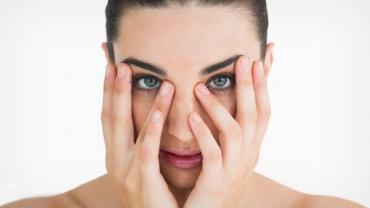
Dark circles under the eyes: Ugh.
They’re the bane of many a woman’s existence and men aren’t immune either.
They make us look older sadder more tired and more stressed out than we actually are. If TV commercials and the volume of products lining drug store shelves are any indication these less-than-desirable facial features have reached epidemic levels and people are desperate for products that can make them disappear—or if not disappear then at least cover them up so it looks like they’ve disappeared.
Periocular or periorbital hyperpigmentation—yes of course there’s a tongue-twisting scientific name for this—is typically considered a cosmetic problem. It’s aesthetically unpleasing and may make people look more run down than they are but that’s about it: they’re skin deep. But is this true? Do dark under-eye circles simply appear with no rhyme or reason or might they be indicative of something going on inside?
Home remedies such as cool compresses (typically made with tea bags or cucumber slices) can help improve the appearance of dark circles or “bags” under the eyes as can expensive and sometimes invasive cosmetic procedures. And as some observant researchers have noted “The extent of the problem is reflected in the sheer number of products on the market advertised to either lighten or cover the pigmentation.” There are entire drugstore shelves dedicated to such products. And while these interventions may help mask the discoloration and skin laxity they don’t address the underlying causes—assuming that is that there are some.
There doesn’t seem to be a consensus on the issue. Some researchers say that while periocular hyperpigmentation is a cosmetic concern for a large number of individuals “it is not a medical concern.” One thing that is known is that while we might have a knee-jerk association between these dark circles and people of older age they affect young and old alike.
So what might be behind these subtle and not-so-subtle “decorations” on our faces?
According to one study’s authors “In most cases we have little information regarding etiology and no gold-standard treatment option.” On the other hand other researchers say that dark circles “are caused by multiple etiologic factors that include dermal melanin deposition postinflammatory hyperpigmentation secondary to atopic or allergic contact dermatitis periorbital edema superficial location of vasculature and shadowing due to skin laxity.” If there’s agreement on anything it’s that dark circles have multiple possible causes.
One potential cause that doesn’t garner as much attention as the others is food sensitivities. These can manifest in surprising and disparate ways. The most obvious are severe allergies such as to shellfish peanuts or tree nuts which can be immediately life-threatening and of course there’s celiac disease an autoimmune destruction of the small intestinal villi and microvilli. Beyond celiac though there’s a range of reactions attributed to non-celiac gluten sensitivity including manifestations in the skin unrelated to dermatitis herpetiformis which is a well-known reaction to gluten. If gluten is known to affect the skin in sensitive individuals then there’s a not-so-small chance that food intolerances—whether to gluten or to some other compound—contribute to under-eye circles. If sensitivities to things like histamine salicylate or FODMAPs can cause digestive emotional cognitive and neurological symptoms it shouldn’t shock us that dark circles could be a manifestation of food intolerance.
Some researchers are making headway along this trail saying that periorbital hyperpigmentation “may be a final common pathway of dermatitis allergy systemic disorders sleep disturbances or nutritional deficiencies…” The Mayo Clinic is on the scent too listing allergies atopic or contact dermatitis or hay fever among the potential causes. They also include the thinning of skin and loss of fat and collagen in the face that occur with aging as making “the reddish-blue blood vessels under your eyes more obvious” but this doesn’t account for noticeable dark circles in children.
Food sensitivities aren’t the only potential diet and lifestyle-related causes of dark under-eye circles. Others are smoking excessive alcohol intake and too much sodium especially when coupled with inadequate potassium. For some individuals expensive creams eye serums and even surgery might seem enticing. However identifying the underlying cause seems to be a much better way to tackle dark circles instead of just covering them up.
Related DFH products:
For more information related to this topic please listen to the following FxMED Podcast: